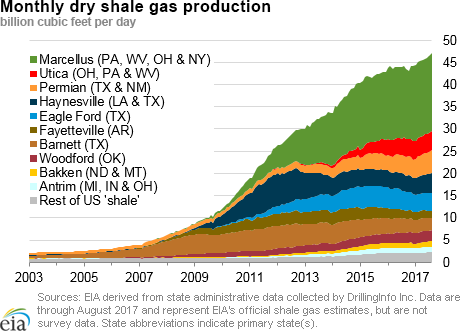In the News:
Hurricane Irma briefly disrupts Florida’s natural gas consumption for electricity generation
Hurricane Irma made landfall on the west coast of Florida on September 10, 2017 as a Category 3 storm, after hitting the Florida Keys earlier the same day as a Category 4 storm. By the afternoon of September 11, Irma—downgraded by then to a tropical storm—moved out of the state leaving nearly two-thirds of customers without power. Correspondingly,electricity consumption in the region covered by the Florida Reliability Coordinating Council (FRCC), which excludes the western part of the Florida panhandle, fell from an average of 0.74 million megawatt hours (MWh) per day during the first week of September to a low of 0.27 million MWh on September 11, a 64% decline.
Natural gas is the most-used fuel for electricity generation in Florida. Natural gas-fired power plants accounted for 65% of electricity generated in Florida for the first six months of 2017, while coal and nuclear plants provided 17% and 13%, respectively (renewables and small amounts of residual fuel oil made up the difference). The Sabal Trail Pipeline was recently built to serve Florida’s growing natural-gas fired electricity generation capacity.
Natural gas use for electricity generation (power burn) in the region covered by the FRCC fell as Irma passed over the state. According to data from PointLogic Energy, power burn fell from an average of 3.3 billion cubic feet per day (Bcf/d) during the first seven days of September 2017 to a low of 2.0 Bcf on September 11, a 41% decrease.
In addition, Florida’s two nuclear power plants—Turkey Point near Miami and St. Lucie on Florida’s east coast—reduced their normal electricity production from September 9 through September 17. Their output was reduced the most on September 12, with Turkey Point completely shut down and St. Lucie running at half capacity.
As residents have returned to their homes and businesses and as utility crews have repaired power lines, both power burn and electricity consumption have approached pre-Irma levels with less than 1% of confirmed customers without power in Florida on September 20, according to the Florida Division of Emergency Management.
Overview:
(For the Week Ending Wednesday, September 20, 2017)
- Natural gas spot prices rose at most locations east of the Rockies this report week (Wednesday, September 13 to Wednesday, September 20). The Henry Hub spot price rose from $2.99 per million British thermal units (MMBtu) last Wednesday to $3.14/MMBtu yesterday.
- At the New York Mercantile Exchange (Nymex), the October 2017 contract price rose 4¢ from $3.058/MMBtu last Wednesday to $3.094/MMBtu yesterday.
- Net injections to working gas totaled 97 billion cubic feet (Bcf) for the week ending September 15. Working natural gas stocks are 3,408 Bcf, which is 4% less than the year-ago level and 2% more than the five-year (2012–16) average for this week.
- The natural gas plant liquids composite price at Mont Belvieu, Texas, rose by 30¢, averaging $7.63/MMBtu for the week ending September 20. The price of natural gasoline, ethane, propane, butane, and isobutane all rose, by 3%, 6%, 4%, 3%, and 3%, respectively.
- According to Baker Hughes, for the week ending Friday, September 15, the natural gas rig count decreased by 1 to 186. The number of oil-directed rigs fell by 7 to 749. The total rig count decreased by 8, and it now stands at 936.
Prices/Supply/Demand:
Spot prices rise in the East and along the Gulf Coast. This report week (Wednesday, September 13 to Wednesday, September 20), warmer temperatures in the eastern half of the country—in some cases more than 10 degrees Fahrenheit (°F) above historical norms—influenced spot price movements. The previous week, temperatures in the East were generally below seasonal norms. The Henry Hub spot price rose 15¢ from $2.99/MMBtu last Wednesday to $3.14/MMBtu on Tuesday and remained at that price yesterday, which is the highest Henry Hub spot price since May 23. At the Chicago Citygate, prices increased 10¢ from $2.95/MMBtu last Wednesday to $3.05/MMBtu yesterday after reaching a weekly low of $2.84/MMBtu on Friday.
At the Algonquin Citygate, which serves Boston-area consumers, prices went up 62¢ from $2.13/MMBtu last Wednesday to $2.75/MMBtu yesterday after a low of $1.53/MMBtu on Friday. Similarly, at the Transcontinental Pipeline Zone 6 trading point for New York, prices increased 73¢ from $2.43/MMBtu last Wednesday to $3.16/MMBtu yesterday, also hitting a weekly low on Friday of $2.28/MMBtu.
Tennessee Zone 4 Marcellus spot prices increased 66¢ from $1.00/MMBtu last Wednesday to $1.66/MMBtu yesterday. Prices at Dominion South in northwest Pennsylvania rose 62¢ from $1.16/MMBtu last Wednesday to $1.78/MMBtu yesterday.
Western spot prices fall. West of the Rockies and in the North Central region, cooler-than-normal temperatures dominated most of the week, with some places in the Northwest and North Central regions experiencing temperatures more than 10°F below normal. The previous week, temperatures in the West were generally above seasonal norms. Prices at PG&E Citygate in Northern California fell 9¢, down from $3.40/MMBtu last Wednesday to $3.31/MMBtu yesterday. The price at SoCal Citygate decreased 11¢ from $3.15/MMBtu last Wednesday to $3.04/MMBtu yesterday.
Nymex prices rise. At the Nymex, the price of the October 2017 contract increased 4¢ from $3.058/MMBtu last Wednesday to $3.094/MMBtu yesterday. The price of the 12-month strip averaging October 2017 through September 2018 futures contracts climbed 2¢ to $3.129/MMBtu.
Supply rises slightly. According to data from PointLogic Energy, the average total supply of natural gas rose by 1% compared with the previous week. Dry natural gas production grew by 1% compared with the previous report week, and average net imports from Canada increased by 9% from last week.
Demand increases. Total U.S. consumption of natural gas rose by 11% compared with the previous report week, according to data from PointLogic Energy. Natural gas consumed for power generation climbed by 23% week over week as Florida electricity generation returned to pre-Irma levels and temperatures rose in the East. Industrial sector consumption decreased by 2% week over week. In the residential and commercial sectors, consumption increased by 5%. Natural gas exports to Mexico decreased 2%.
Puerto Rico (which is not covered by PointLogic’s supply and demand numbers) lost power to nearly all of its electricity customers as of Thursday morning after being hit by hurricanes Irma and Maria. Puerto Rico generated about one-third of its electricity from natural gas in 2015, all of which was imported as liquefied natural gas (LNG). In the first seven months of 2017, Puerto Rico imported an average of 0.15 Bcf/d of LNG.
U.S. LNG exports increase. Five LNG vessels (combined LNG-carrying capacity 17 Bcf) departed Sabine Pass terminal during the report week (Thursday to Wednesday) and one vessel (LNG-carrying capacity 3.8 Bcf) was loading at the terminal on Wednesday, September 20.
Storage:
Net injections to working gas stocks top 90 Bcf for the second week in a row. Net injections into storage totaled 97 Bcf for the week ending September 15, compared with the five-year (2012–16) average net injection of 73 Bcf and last year's net injections of 54 Bcf during the same week. This week had the largest net injection since June 2, when net injections into working gas totaled 106 Bcf. Low power demand for natural gas resulting from mild temperatures and increased production likely contributed to increased injections. Net injections into storage exceeded the five-year average by 4 Bcf in the East region and by 2 Bcf in the Midwest region. By far, the largest gain versus the five-year average occurred in the South Central salt region, where net injections totaled 19 Bcf, topping the five-year average by 14 Bcf. Working gas stocks totaled 3,408 Bcf, which is 67 Bcf more than the five-year average and 136 Bcf less than last year at this time.
Working gas stocks poised to end refill season near 3,900 Bcf. So far during the 2017 refill season, net injections into storage have fallen 15% lower than the comparable five-year average—188 Bcf during the 2017 refill season compared with the five-year average increase of 136 Bcf. However, the rate of net injections accelerated during the two most recent report weeks, topping the five-year average net injection for these two weeks by 52 Bcf. If net injections fall 15% lower than the five-year average going forward, then working gas stocks will reach 3,834 Bcf by the end of the refill season. However, working gas stocks will total 3,909 Bcf if net injections into working gas match the five-year average for the remainder of the refill season.
The South Central region posts the largest net injection of the 2017 refill season. Working gas stocks in the South Central region rose by 33 Bcf on the week— the largest net injection for this region in the 2017 refill season. For the second week in a row, the salt facilities led the way, posting net gains of 19 Bcf—the highest weekly net injections of the 2017 refill season. Working gas stocks at salt dome facilities in the region now exceed last year’s level at this time by 25 Bcf. However, total South Central working gas levels remain 42 Bcf lower than the level reported last year at this time.
The January 2018 futures price continues trading at a premium over the current spot price. During the most recent storage week, the average natural gas spot price at the Henry Hub was $2.92/MMBtu, while the Nymex futures price of natural gas for delivery in January 2018 averaged $3.32/MMBtu, a difference of 40¢. The premium was 31¢ a year ago. The average natural gas spot price at the Henry Hub was 7¢ lower than the front-month futures price at the Nymex. A year ago, the spot price was 11¢ higher than the front-month contract.
Reported net implied flows into storage are on the high side of analysts’ expectations. According to the Desk survey of natural gas analysts, estimates of net injections to working natural gas storage ranged from 84 Bcf to 101 Bcf with a median of 90 Bcf. Prices on the futures contract for October delivery fell about 1¢/MMBtu to $3.02/MMBtu with 529 contracts traded at the release of the Weekly Natural Gas Storage Report (WNGSR). In an increasingly common phenomenon, heavier trading occurred in the moments following the initial release. Prices fell in subsequent trading to $2.99/MMBtu, with one spike in trading activity exceeding 900 contracts per second.
Temperatures are cooler than normal in most of the Lower 48 states east of the Rockies. Temperatures in the Lower 48 states averaged 67°F, 2°F lower than the normal and 7°F lower than last year at this time. Temperatures west of the Rockies were generally warmer than normal. Temperatures in the Mountain Census division averaged 74°F, 7°F higher than the normal and 4°F higher than last year at this time, and temperatures in the Pacific Census division averaged 71°F, 3°F higher than the normal and 2°F higher than last year at this time.
See also:
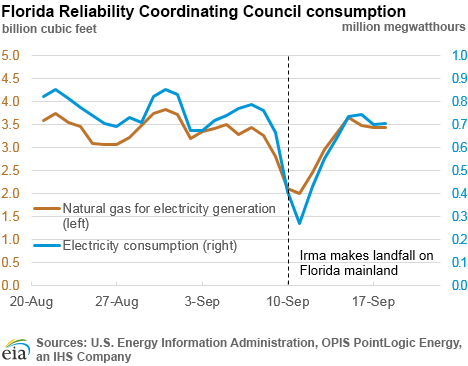
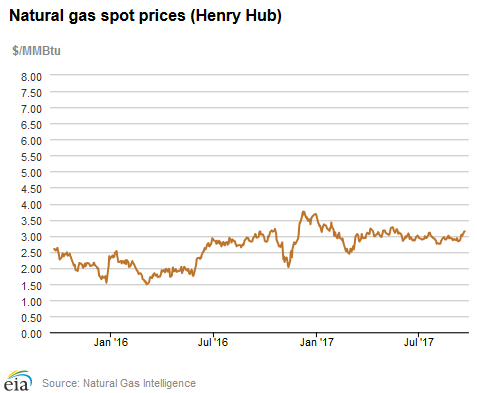
| Spot Prices ($/MMBtu) | Thu, 14-Sep |
Fri, 15-Sep |
Mon, 18-Sep |
Tue, 19-Sep |
Wed, 20-Sep |
|---|---|---|---|---|---|
| Henry Hub |
3.04 |
2.99 |
3.10 |
3.14 |
3.14 |
| New York |
2.56 |
2.28 |
3.08 |
3.17 |
3.16 |
| Chicago |
2.94 |
2.84 |
3.00 |
3.02 |
3.05 |
| Cal. Comp. Avg.* |
2.99 |
2.85 |
3.02 |
3.00 |
2.91 |
| Futures ($/MMBtu) | |||||
| October Contract | 3.070 |
3.024 |
3.146 |
3.122 |
3.094 |
| November Contract |
3.127 |
3.085 |
3.195 |
3.175 |
3.149 |
| *Avg. of NGI's reported prices for: Malin, PG&E Citygate, and Southern California Border Avg. | |||||
| Source: NGI's Daily Gas Price Index | |||||
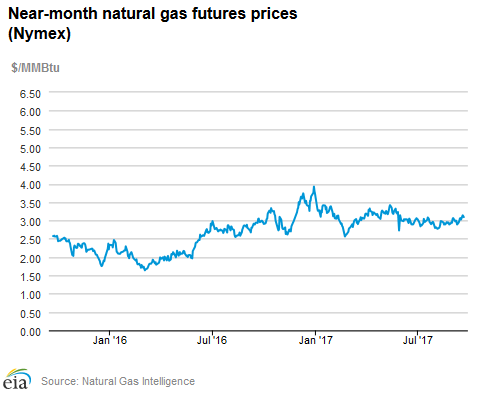
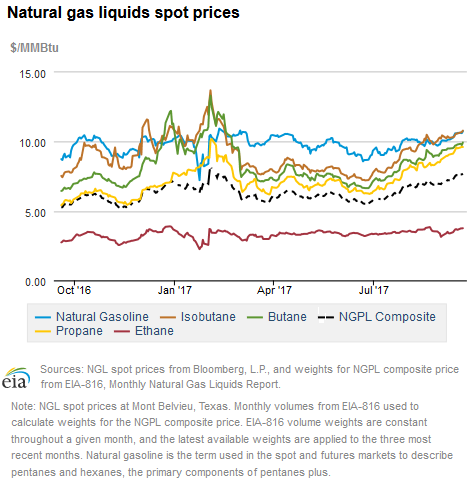
| U.S. natural gas supply - Gas Week: (9/14/17 - 9/20/17) | |||
|---|---|---|---|
Average daily values (Bcf/d): |
|||
this week |
last week |
last year |
|
| Marketed production | 83.8 |
83.1 |
78.4 |
| Dry production | 74.5 |
73.9 |
70.0 |
| Net Canada imports | 5.7 |
5.2 |
5.9 |
| LNG pipeline deliveries | 0.0 |
0.1 |
0.1 |
| Total supply | 80.2 |
79.1 |
75.9 |
|
Source: OPIS PointLogic Energy, an IHS Company | |||
| U.S. natural gas consumption - Gas Week: (9/14/17 - 9/20/17) | |||
|---|---|---|---|
Average daily values (Bcf/d): |
|||
this week |
last week |
last year |
|
| U.S. consumption | 57.9 |
52.0 |
57.0 |
| Power | 31.1 |
25.2 |
30.9 |
| Industrial | 19.5 |
19.8 |
19.3 |
| Residential/commercial | 7.3 |
7.0 |
6.7 |
| Mexico exports | 4.0 |
4.1 |
4.1 |
| Pipeline fuel use/losses | 6.4 |
5.8 |
6.3 |
| LNG pipeline receipts | 2.8 |
2.1 |
0.5 |
| Total demand | 71.1 |
63.9 |
67.9 |
|
Source: OPIS PointLogic Energy, an IHS Company | |||
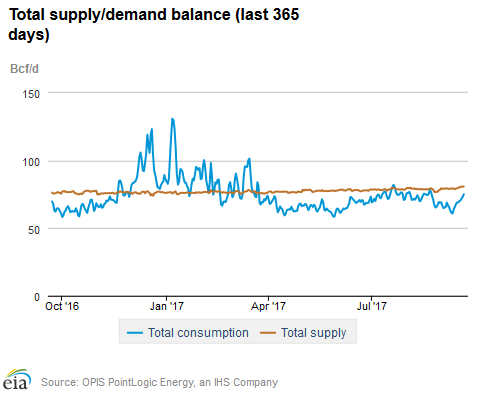
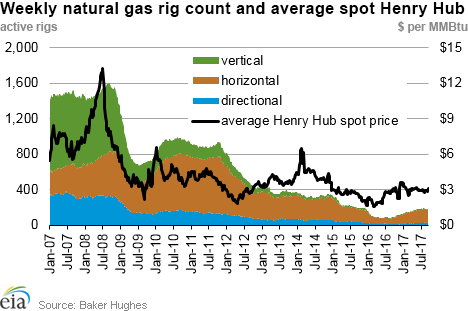
| Rigs | |||
|---|---|---|---|
Fri, September 15, 2017 |
Change from |
||
last week |
last year |
||
| Oil rigs | 749 |
-0.9% |
80.0% |
| Natural gas rigs | 186 |
-0.5% |
109.0% |
| Note: Excludes any miscellaneous rigs | |||
| Rig numbers by type | |||
|---|---|---|---|
Fri, September 15, 2017 |
Change from |
||
last week |
last year |
||
| Vertical | 67 |
-10.7% |
4.7% |
| Horizontal | 795 |
0.3% |
101.8% |
| Directional | 74 |
-2.6% |
54.2% |
| Source: Baker Hughes Inc. | |||
| Working gas in underground storage | ||||
|---|---|---|---|---|
Stocks billion cubic feet (Bcf) |
||||
| Region | 2017-09-15 |
2017-09-08 |
change |
|
| East | 833 |
809 |
24 |
|
| Midwest | 938 |
906 |
32 |
|
| Mountain | 212 |
208 |
4 |
|
| Pacific | 300 |
296 |
4 |
|
| South Central | 1,125 |
1,092 |
33 |
|
| Total | 3,408 |
3,311 |
97 |
|
| Source: U.S. Energy Information Administration | ||||
| Working gas in underground storage | |||||
|---|---|---|---|---|---|
Historical comparisons |
|||||
Year ago (9/15/16) |
5-year average (2012-2016) |
||||
| Region | Stocks (Bcf) |
% change |
Stocks (Bcf) |
% change |
|
| East | 848 |
-1.8 |
813 |
2.5 |
|
| Midwest | 981 |
-4.4 |
926 |
1.3 |
|
| Mountain | 230 |
-7.8 |
199 |
6.5 |
|
| Pacific | 318 |
-5.7 |
336 |
-10.7 |
|
| South Central | 1,167 |
-3.6 |
1,066 |
5.5 |
|
| Total | 3,544 |
-3.8 |
3,341 |
2.0 |
|
| Source: U.S. Energy Information Administration | |||||
| Temperature – heating & cooling degree days (week ending Sep 14) | ||||||||
|---|---|---|---|---|---|---|---|---|
HDD deviation from: |
CDD deviation from: |
|||||||
| Region | HDD Current |
normal |
last year |
CDD Current |
normal |
last year |
||
| New England | 22 |
0 |
20 |
6 |
0 |
-50 |
||
| Middle Atlantic | 23 |
9 |
23 |
6 |
-11 |
-59 |
||
| E N Central | 36 |
17 |
32 |
2 |
-15 |
-46 |
||
| W N Central | 12 |
-13 |
0 |
29 |
4 |
-11 |
||
| South Atlantic | 18 |
15 |
18 |
47 |
-20 |
-58 |
||
| E S Central | 20 |
17 |
20 |
23 |
-33 |
-69 |
||
| W S Central | 2 |
0 |
2 |
56 |
-33 |
-54 |
||
| Mountain | 2 |
-28 |
-14 |
66 |
22 |
13 |
||
| Pacific | 2 |
-8 |
-3 |
47 |
14 |
14 |
||
| United States | 17 |
3 |
13 |
31 |
-10 |
-37 |
||
|
Note: HDD = heating degree day; CDD = cooling degree day Source: National Oceanic and Atmospheric Administration | ||||||||
Average temperature (°F)
7-Day Mean ending Sep 14, 2017
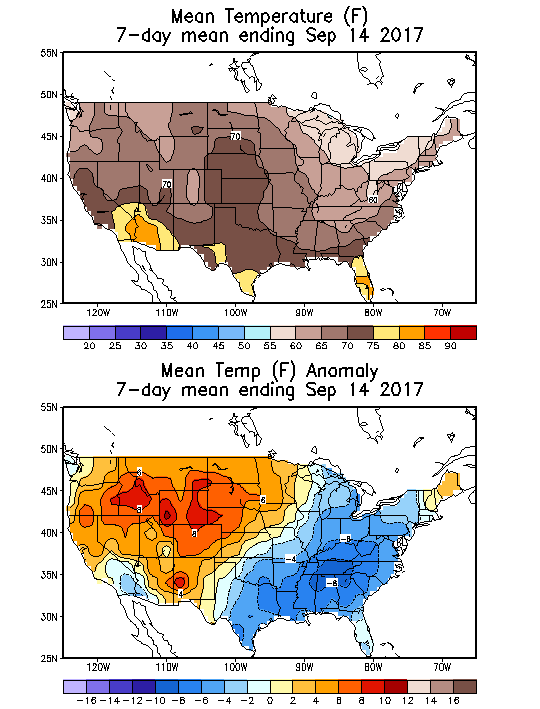
Source: NOAA National Weather Service
Deviation between average and normal (°F)
7-Day Mean ending Sep 14, 2017

Source: NOAA National Weather Service

